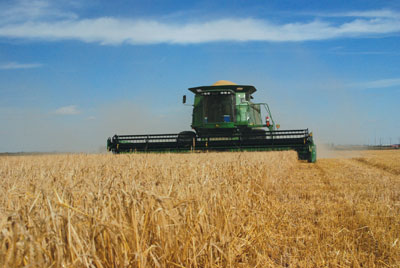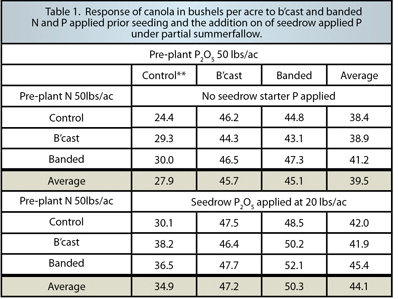
Features
Agronomy
Tillage
Canola versus barley response to N-P placement options
his article has been quite difficult for me to prepare and you may find it difficult to read. It is based on less canola research than I would have liked to have available. Nevertheless, I feel that this is an issue that needs to be discussed.
May 1, 2009 By John Harapiak
This article has been quite difficult for me to prepare and you may find it difficult to read. It is based on less canola research than I would have liked to have available. Nevertheless, I feel that this is an issue that needs to be discussed. Canola responds differently to fertilizer placement than cereal crops do.
 |
| In Westco Agronomy research trials, top yields of barley and canola were achieved using different N-P fertilizer placement options. Photo by Bruce Barker. |
Fewer canola fertilizer trials
Most canola fertilizer research has focused on using higher N rates to boost yields. Westco conducted far less fertilizer placement trials with canola than was the case with barley. However, there were sufficient results available to alert the Westco researchers to the fact that canola appeared to be responding differently than barley to the various N-P placement options that were available. The long-term trends for barley were discussed in a previous column titled “Rating of the various options for band application of P.”(Page 36, Top Crop Manager (West) February 2008; www.topcropmanager.com/content/view/1269/67/)
 |
N and P response on partial fallow
In 1979 a canola trial was established by the Westco Agronomy Department for the purpose of evaluating the impact of various combinations of broadcast and/or banded N and P applied prior to seeding. In addition, the response to an application of seedrow applied P with each of the pre-plant options (see Table 1) was also assessed. The field was partially fallowed, as it had been broken out of mixed hay production in the previous year, after the first hay crop had been harvested. This research trial was located in the Black soil zone of western central Alberta.
Band and seedrow P achieve top yields
The most striking aspect of the yield information that was generated from this detailed evaluation of N-P fertilizer placement options was the fact that the top yields of canola were achieved when fertilizer P was applied in both the seedrow, as well as being band applied. With no seedrow P, the canola achieved a yield of 24.4 bu/ac and the yield was increased to 30.1 bu/ac with application of seedrow P. Application of banded N and P increased canola yield to 47.3 bu/ac, while banded N and P plus seedrow P boosted average yield to 52.1 bu/ac.
Is P more critical for canola than barley?
Insertion of a single year of canola into a long-term N-P placement trial that was normally seeded to barley also generated some interesting data (see Table 2). In contrast to barley, canola was much less responsive to a N band application of 80 lbs/ac (i.e. 14 versus. 1 bu/ac). This suggests that P fertilization is of critical importance in canola production. It also indicates that canola may be less able to efficiently utilize extra fertilizer N, when P is more limiting than usual. This appears to be less so for barley. The information in Table 2 was generated from 12-year study that was established on the University of Alberta Research Farm located at Ellerslie.
Canola benefits from deeper N-P bands
Whilst there was a slight yield disadvantage resulting from the deeper band application in the case of barley (i.e., 1 to 6 bu/ac), there appeared to be a 3 to 5 bu/ac yield advantage for deeper N-P band placement in the case of canola (Table 2). However, this advantage disappeared for canola when only fertilizer N was being band applied. In the case of barley, deeper band application of N resulted in a yield loss of 2 bu/ac.
Second long-term trial provides useful data
A single crop of canola was also inserted into a longer-term barley trial (i.e., 21 years in duration), the results from which are summarized in Table 3. In this study, 1 tonne/ha (892.2 lbs/ac) of 0-45-0 was broadcast and incorporated into one-half of the plot area in order to evaluate the potential long-term benefits of building-up the soil P levels on crop production. This 21-year study was also located on the University of Alberta Research Farm at Ellerslie.
Residual P boosts yields
For the N band treatment, in the case of barley, the single soil-building application of half a ton of 0-45-0 increased average barley yield by 17.5 bu/ac, while canola yield was increased by 6 bu/ac, thereby, demonstrating potential benefits for building soil P levels. When N was either broadcast or band applied and P was applied in the seedrow, the ”P build” approach was less effective in increasing canola yields. However, in the case of barley, for the same two N-P treatments, the “P build” approach resulted in a yield advantage of 4 to 5 bu/ac. Similar trends in canola and barley yields were evident for the two N-P band treatments with the “P build” application boosting barley yields by 4 to 5 bu/ac while reducing canola yields by 2 to 3 bu/ac.

|
Top barley and canola yields
The top yields of barley and canola were not achieved with the same fertilizer treatments. In the case of canola, top yields (64.9 bu/ac) were achieved with the split application of P (i.e. one-third in the seedrow and two-thirds in the N-P band) where there was no “P build” application and canola yield was decreased by 2.5 bu/ac for the split treatment where a “P build” was included. In the case of barley, the top yield of 108.2 bu/ac was achieved using P applied in the seedrow as well as in the band application where the “P build” approach had been utilized. Where the “P build” approach was not utilized, barley yield was 4.9 bu/ac lower.
 |
Building of soil P questionable
It may not be practical to incorporate some of the agronomic fertilizer placement information that has been revealed in these fertilizer trials. For example, given the current high prices for fertilizer, a soil “P build” program involving broadcasting and incorporating higher rates of P fertilizer may not be practical. The fact that canola responded negatively to what was an excessive “P build” approach suggests that the extra P may have tied-up some micronutrients that were more critical to production of canola than for barley.
My “Take Home Canola Message”
Canola is a high value crop so you may want to consider tailoring your fertilizer application system to this crop. For growers who use pre-plant band applications of fertilizer, I would encourage them to apply some, but not all of their required P along with the banded N. Apply 20 to 30 percent of the P either in, or near the seedrow. The same message applies to irrigation growers who broadcast apply fertilizer for canola production. Apply some seedrow P at planting!!!
For growers who use seeding equipment that can apply fertilizer in the seedrow as well as in the side-band or mid-row-band position, for best results with canola try applying a portion of the same N-P blend within the seedrow as well as in the side-band or mid-row band position. I do not think that you need a separate high P blend for applying in the seedrow unless your blend contains a very low amount of P. By using one N-P blend you might be able to reduce your handling costs and refill down time.
